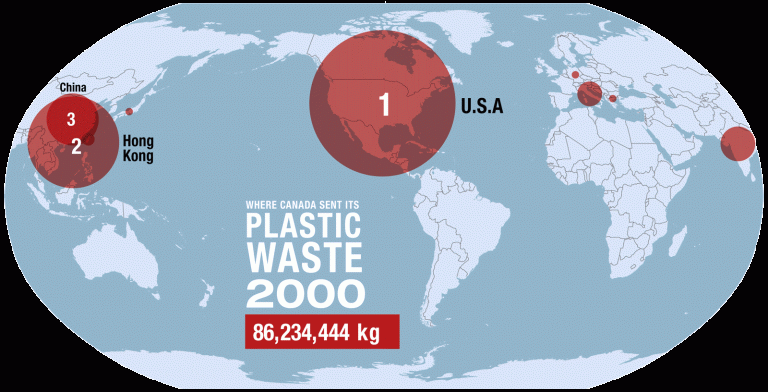Where Canada sends its garbage

One man’s trash is another man’s treasure. So goes the well worn idiom. When it comes to Canadian waste being shipped overseas, however, we’re increasingly seeing countries refuse to accept it. But where’s it going? And why?
Prior to January 2018, Canada shipped about half of its recycling exports to China, which imported about 45 per cent of the world’s global waste. Most of this imported plastic was simply burnt, while valuable materials were extracted for use. This in early 2018 when China banned imports of 24 types of solid waste, including unsorted paper and many types of plastics, such as the variety used to make plastic bottles.
As a result of China’s policy shift, much of the world’s waste has been shifted to other nations in southeast Asia. These countries often have lax environmental regulations and the waste is disposed of by dumping or burning it, enabling them to charge far less for its disposal.
Malaysia is now bearing the brunt of the waste flow, according to Greenpeace and Reuters. Malaysia’s intake of garbage rose from 168,000 tonnes in 2016 to 456,000 tonnes in the first six months of 2018.
Canada and other countries are now shipping waste to Malaysia, Indonesia, Vietnam and the Philippines, but these countries are becoming increasingly worried that the environmental costs are greater than the income they earn from importing the waste.
Because a significant percentage of this imported trash is composed of mixed municipal waste that cannot be recycled, much of its ends up illegally incinerated on roadsides and dumped in unregulated landfills, where it releases highly poisonous fumes, or is dumped in rivers from where it finds its way to the ocean.
Many Asia nations are now following China’s example and saying no to the legal import of waste, but the illicit trade remains a major problem.
Although the Canadian government has issued no new permits for Canadian companies to ship trash overseas since regulations changed three years ago, trash is still ending up abroad.
Canada exported 101,131 tonnes of plastic waste in 2018, much of it to American recycling brokers, who then resell it to overseas companies. Once Canadian waste enters the U.S., it is not tracked so where it ends up is a mystery. Reportedly, it is often mixed with American waste and sent to Asia.
As more Asian countries block the import of waste from North America, or attempt to return contaminated waste, more of our garbage is going to be dumped into landfills. As much as 2.8 million tonnes, the weight of 24 CN Towers now ends up in Canadian landfills. There is currently no market for many of the materials that are collected for recycling.
Canadians produce 3.25 million tonnes of plastic waste each year. Less than 10 per cent of the plastic we toss out is diverted from landfills, and not all of what is diverted is recycled.
It is difficult to get an accurate breakdown of the export paths of garbage in Canada because cities all dispose of waste differently. In Vancouver, for example, plastic containers, plastic bags and overwrap remain in British Columbia, with a local Vancouver company processing the material into pellets that can be manufactured into new packaging and other products. Glass, meanwhile, is shipped to Abbotsford to be processed into new bottles and to Quesnel to be made into sandblast materials. Metal containers are sold to markets in B.C., Ontario and the U.S., and can be recycled into new packaging, such as aluminum cans and sheet metal for automotive manufacturing. Foam packaging is recycled locally in Vancouver or overseas, and is made into items such as picture frames and crown moulding.
Vancouver’s landfill has a limit of 750,000 tonnes of trash per year. It regularly exceeds that limit and so overflow is exported to landfills in Washington and Oregon. In Ontario, excess municipal garbage is sent to landfills in Michigan.
British Columbia has led the way in Canada by passing legislation that has shifted the onus of handling recycling onto the businesses that create the waste, something known as “extended producer responsibility.” Recycle B.C., a non-profit, took responsibility for the province’s waste recycling about five years ago. It works to keep contamination levels low, so its recycled products are usually higher quality, making them easier to sell.
Although most Canadians don’t realize it, a municipal government’s responsibility ends once blue bin contents are sold to a recycling company. Waste and recycling are largely handled by private industry in Canada. Canadian recycling companies take the material from municipal programs and sort and clean it and compress it into smaller cubes. Those cubes are then put up for auction. After that point, municipalities have no way, or responsibility, of knowing where it goes.
